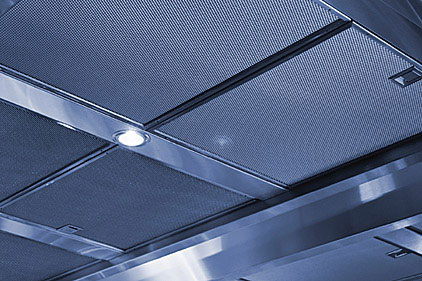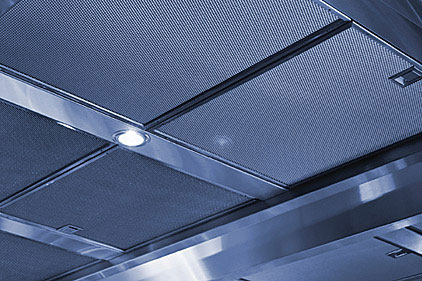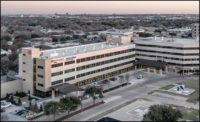 Managing smoke during a fire incident in a health care facility is critical because the fire/life safety strategy is to protect the occupants of the building while minimizing the need to evacuate or relate patients. It is necessary to provide a tenable environment in at least designated portions of the building for an extended period of time and to also limit the number of patients exposed to the fire and potentially needing to be evacuated or relocated. To accomplish the goal of defending the occupants in place, smoke will need to be managed by a combination of active and passive features within the building.
Managing smoke during a fire incident in a health care facility is critical because the fire/life safety strategy is to protect the occupants of the building while minimizing the need to evacuate or relate patients. It is necessary to provide a tenable environment in at least designated portions of the building for an extended period of time and to also limit the number of patients exposed to the fire and potentially needing to be evacuated or relocated. To accomplish the goal of defending the occupants in place, smoke will need to be managed by a combination of active and passive features within the building.CODE REQUIREMENTS
Virtually all health care facilities in the U.S.A. are required to comply with the Life Safety Code®, NFPA 101®(i) for purposes of meeting the requirements for certification by the Centers for Medicare & Medicaid Services (CMS). While current licensing, certification, and accreditation programs in the United States require compliance with the 2000 Edition of NFPA 101, CMS has announced the intent to adopt the 2012 Edition. For this reason, all code requirements and references contained in this article will be based upon the NFPA 101-2012 Edition, unless otherwise noted.
The article will also presume that the building is not a high-rise building. Additional requirements and smoke control considerations for high-rise buildings are summarized in the sidebar. The history and evolution of those requirements has been addressed by Gilyeat and Talley.(ii)
LIMITING THE QUANTITY OF SMOKE PRODUCED
While there are several requirements in NFPA 101 that address fire growth and spread, the primary means by which the size of the fire and smoke are controlled in a health care facility is a requirement that all new buildings containing a health care occupancy shall be protected with an automatic sprinkler system.
Furthermore, quick response or residential sprinklers(iii) shall be installed in smoke compartments containing patient sleeping and treatment rooms. This requirement was first introduced into NFPA 101 in the 1991 Edition and incentives are included in the Code to encourage existing health care occupancies to also be protected with fast response sprinklers. The requirement to install fast response sprinklers was based upon computer modeling indicating that such sprinklers will maintain tenability in the room of origin from most credible fire scenarios.(iv) The results of the modeling were then confirmed by full scale fire tests performed by the Center for Fire Research at NIST.(v)
Actuation of the sprinklers typically provides for fire control during initial development and growth, resulting in reducing the amount of smoke produced and the smoke that is produced has less buoyancy than what could occur in a building that is not protected with an automatic sprinkler system.
CONTAINING SMOKE TO THE ROOM OF ORIGIN
In most health care facilities, the HVAC system consists of a ducted supply and a ducted return. When that is the case, the NFPA 101 requires corridor walls to be constructed of assemblies capable of resisting the passage of smoke, providing a passive means of controlling the smoke to the room of origin. The requirement is also intended to maintain tenability in the corridor, providing a means to relocate patients should it be necessary to do so. NFPA 101 permits the corridor walls to terminate at the underside of a floor/ceiling or roof/ceiling assembly provided the ceiling membrane is capable of resisting the passage of smoke. While NFPA 101 permits the ceiling to be a suspended ceiling system, it should be noted that the International Building Code® (vi) (IBC) does not consider a suspended ceiling system to be capable of resisting the passage of smoke.
The HVAC system can contribute to the spread of smoke across a corridor wall when the HVAC system involves a supply or return plenum. When a plenum is used, the ceiling membrane clearly does not resist the passage of smoke due to the air movement that normally occurs between the room and plenum, through the ceiling membrane. When this is the case, the corridor wall must continue to the underside of the floor slab or roof slab above to limit the spread of smoke across the corridor wall. NFPA 101 does not permit transfer grilles in corridor walls which further compound the use of plenums in health care facilities.(vii) While plenums are not prohibited, NFPA 101 essentially eliminates an arrangement in which a single plenum serves rooms on both sides of the corridor or rooms and a corridor.
To complete the passive smoke control feature, corridor doors shall be provided with door hardware that is self-latching and positive-latching. Any penetrations of the wall below the ceiling membrane are required to be protected in a manner in which the performance requirement of the wall to restrict the spread of smoke is maintained. Should the corridor wall be required to extend to the roof deck or floor slab above, penetrations above the ceiling are also required to be protected to restrict smoke spread. NFPA 101 would not require smoke dampers in the duct penetrations of such corridor walls. As noted above, the quantity and buoyancy of the smoke is presumed to be reduced by the fast response sprinklers
BEYOND THE ROOM OF ORIGIN
While the combination of sprinkler protection and the separation between the room and corridor requiring construction capable of resisting the passage of smoke should restrict the need to evacuate patients from other than the room of origin and immediately adjacent rooms, the code still requires smoke compartments created by passive smoke barriers. While there are many requirements related to smoke barriers, four are of significance with respect to protecting the occupants:
- Maximum smoke compartment. Most codes limit the area of a smoke compartment to 22,500 sq ft, which has an effect of limiting the number of occupants that may be exposed to a fire within a smoke compartment. Recent code change activity in both the NFPA and ICC processes has proposed to increase the area to 40,000 sq ft.(viii)
- Minimum size of the area of refuge. While not establishing a minimum area of a smoke compartment, NFPA 101 requires a mini-mum area to be provided in adjacent smoke compartments to accommodate the occupants that may be relocated to the smoke compartments should people need to be relocated to an adjacent smoke compartment. The minimum area is a function of the occupancy classification of the area served.
- Travel distance to the smoke barrier door. In an attempt to address the time required to relocate occupants to an adjacent smoke compartment, NFPA 101 restricts the travel distance to a door of the smoke barrier. The travel distance to the smoke barrier door is restricted, even if an exit is located closer than the smoke barrier door.
- The smoke barrier is continuous from floor slab to the roof deck or floor slab above with all penetrations properly protected. While not required by NFPA 101, the IBC contains requirements for a leakage rating for through penetration firestop systems used in smoke barriers.
From a building systems perspective, obviously the codes are concerned with smoke migration through ducts that may penetrate the smoke barrier. Historically, smoke dampers (actually air leakage rated dampers listed in accordance with UL 555S) have been required at duct penetrations of smoke barriers. Once fast response sprinklers were required in all smoke compartments containing patient sleeping or treatment rooms, NFPA 101 deleted the requirement for smoke dampers. The rationale was that a limited amount of smoke might spread across the smoke barrier due to the reduced smoke and the reduced buoyancy of the smoke produced when the fire is being controlled by the fast response sprinklers. Full scale fire tests have demonstrated that peak optical density and carbon monoxide concentrations on a fire floor vary by a factor of approximate 30 when comparing a fire controlled by a sprinkler system versus an uncontrolled fire. (ix) The fire tests also showed that the heat release rate of a fire in a room without sprinkler protection can decrease significantly after 15 minutes due to decreased oxygen levels.
In addition to the control of the fire by the automatic sprinkler system, the omission of smoke dampers at duct penetrations has been based upon additional factors.
During the NFPA 101 debate on the issue, hospital facilities expressed concern over the time and cost associated with testing the dampers. Newer technology is available to reduce the ongoing cost, but such technology does increase the initial cost of the system. During a more recent discussion of the same issue at an ICC hearing, testimony was provided indicating that the omission of smoke dampers would assist facilities in their need to address infection control.(x)
HORIZONTAL EXITS
Another concept permitted by the codes to address the relocation of patients in a health care facility is the use of horizontal exits. A horizontal exit consists of a fire barrier having a fire resistance rating of at least two hours and again, providing a minimum area on the other side of the barrier to accommodate patients or occupants that are relocated to the other side of the horizontal exit. If a building is not protected by an automatic sprinkler system, duct penetrations of smoke barriers are typically prohibited. However, again recognizing the benefit received by using fast response sprinklers, NFPA 101 does not restrict duct penetrations of horizontal exits in new health care occupancies.
ENGINEERED SMOKE CONTROL SYSTEMS
Other than smoke control systems that may be required due to the building being a high-rise building, codes in the U.S.A. typically do not require an engineered smoke control system in health care occupancies. The Department of Veterans Affairs installed engineered smoke control systems in numerous facilities many years ago and reported a high failure rate of the systems when tested. It should be noted, however, that those systems predated current standards for such systems, such as NFPA 92.(xi)
Where an engineered smoke control system is provided, the design should be coordinated with the previously mentioned require-ments for passive smoke compartments. Codes do permit the use or elimination of smoke dampers as required for proper operation of the engineered smoke control system.
OTHER SMOKE CONTROL FEATURES
NFPA 101 requires that all floors be constructed as a smoke barrier although duct penetrations of such floors are not required to be protected with smoke dampers. NFPA 101 also requires compliance with NFPA 90A,(xii) which contains several key smoke control requirements.
- The corridor of a health care facility may not be used as part of the supply or return for the building HVAC system.
- Smoke detection is required downstream of the supply fan and filter to initiate system shutdown should the smoke detector detect smoke in the duct.
- Smoke detection and controls are required to prevent the recirculation of smoke from the return system.
While the last two provisions have thresholds with respect to the capacity of the supply and return systems, in a health care facility these capacities are typically exceeded.
SUMMARY
While NFPA 101 does not require engineered smoke control systems in all health care occupancies, the code does address smoke control using a variety of passive and active features of the building. The ability to effectively control smoke during a fire in a health care facility is critical due to the protection strategy of protecting or defending the occupants in place, thereby minimizing the need to evacuate or relocate patients. However, the code continues to require features that will result in providing an area of refuge should patients need to be relocated during a fire.
Smoke Control in High-Rise Buildings
High-rise building designs involve several inherent challenges related to smoke movement, including: pronounced “stack effect”; wind effect; piston effect from the elevators; extended egress times; the need to defend-in-place; and protection of firefighters during their emergency operations. Engineered smoke control systems can be employed in high-rise buildings, which use mechanical means to produce pressure differentials across barriers to inhibit smoke spread.
Common types of engineered smoke control systems in high rises and very tall buildings include:
- Atrium smoke control systems — These systems are required for open atriums and consist of a mechanical smoke exhaust system to extract smoke from the top of the open atrium while providing low-level, low-velocity make-up air at the bottom of the atrium in order to maintain the smoke layer above the occupied areas and their associated means of egress for a specified time period.
- Smokeproof stair enclosures — Most building codes require high rise buildings to be provided with smokeproof exits stairs. The International Building Code (IBC) allows three methods for compliance: exterior stair balconies; mechanically ventilated stair vestibules; or stair pressurization. Mechanical stair pressurization is the most commonly used approach to meet this requirement for high rise buildings in the U.S.
- Pressurized elevator hoistways — The IBC permits the omission of elevator lobbies if a hoistway pressurization system is provided. In order to meet the aesthetic and functional needs of the building, this design option is often chosen.
- Post-fire smoke removal — Post-fire smoke removal systems are intended to facilitate smoke removal during post-fire salvage and overhaul operations. To meet this requirement, the current IBC and various previous codes have allowed operable windows/panels, or mechanical equipment capable of providing a prescribed number of air changes per hour.
- Zoned smoke control system — The building is divided into separate smoke control zones and mechanical equipment creates pressure differentials to inhibit smoke spread. Mechanical exhaust is provided for the areas containing smoke and pressurization is provided for the other contiguous zones. In a high rise building, zones may consist of entire floors, but sometimes floors are subdivided into multiple zones
Fire protection engineering principles have been developed over time to the point where we can now model and analyze the primary driving forces behind smoke movement in buildings. Computer models and software have been developed to assist with the evaluation of smoke movement within buildings, incorporating the influences of fire size, location, stack effect, wind, and HVAC systems. Ultimately, in high-rise building designs, these computational methods will be necessary to provide some level of “performance-based design” rather than simply adhering to prescriptive code requirements in order to ensure a safe, efficient, and viable smoke control strategy.
FOOTNOTES
i Life Safety Code®, NFPA 101®, 2012 Edition.
ii “Smoke Control in High-Rise Buildings,” Life Safety Digest, Vol. 8, No. 3, Fall 2012.
iii Quick response and residential sprinklers are both considered fast response sprinklers and for that reason the phrase fast response sprinklers will be used throughout the remainder of the article.
iv Koffel, W., “Estimating The Effectiveness of State-of-the-Art Smoke Detectors and Automatic Sprinklers on Life Safety in Hospitals,” Technical Document Series 055894, Chicago, IL: American Society for Hospital Engineering, 1987.
v Notarianni, K., “Measurement of Room Conditions and Response of Sprinklers and Smoke Detectors During a Simulated Two-Bed Hospital Patient Room Fire,” NISTIR
vi 2012 International Building Code®, Country Club Hills, IL: International Code Council, 2011.
vii NFPA 101, Paragraph 18.3.6.4.1.
viii The increased smoke compartment size has already been approved for the 2015 Edition of the IBC and is being considered for the 2015 Edition of NFPA 101.
ix Klote, J., Fire Experiments of Zoned Smoke Control at the Plaza Hotel in Washington, D.C., National Institute of Standards and Technology, 1980.
x Testimony provided by Traci Henegan, Principal, Coffman Engineers, October, 2012.
xi Standard for Smoke Control Systems, NFPA 92, 2012 Edition.
xii Standard for the Installation of Air-Conditioning and Ventilating Systems, NFPA 90A, 2012 Edition.






